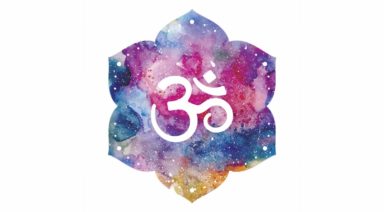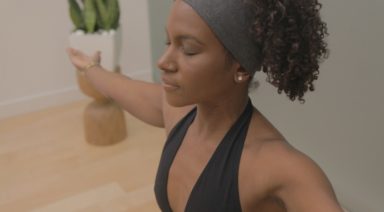7 Ways to Be More Yogic Without Striking a Single Pose

I’m always thinking about whether there are any changes I can make in my life to improve some aspect of it, whether that be the health of me and my family, my relationships or my level of productivity. This is not meant to sound all holier-than-thou, because in reality it’s like having the stress of making and keeping New Year’s resolutions every day.Despite being a little intense, I find that making several adjustments throughout the year is actually a much more manageable practice than trying to make them all at once on January first.
Right now the thing that keeps popping into my mind is that I can, or maybe more accurately I should, pay more attention to integrating more yogic principles into my approach to everyday life.
As a yoga instructor I trained in a very physical type of yoga and can’t claim that the spiritual aspects of it factored in very much for me in the early years. But over time, and as I have continued to learn more about yoga, I’ve realized that the very many different aspects of yoga, besides just the physical practice, have become important guiding principles in my life. Probably more significantly, these lifestyle principles are guiding how my husband and I choose to raise our children.
The physical practice of yoga poses (Asanas) is just one arm of the Eight Fold Path of Yoga as laid out in The Yoga Sutras of Patanjali. The Yamas and Niyamas are two more “arms” of the Eight Fold Path and it’s many of the elements of these two parts of yoga that I think lend themselves to a holistically healthy yogic lifestyle.
The Yamas
Ahimsa, Satya and Astheya
The Yamas are described as “wise characteristics” which are supposedly our natural way of operating in relation to one another. Ahimsa, for example, is the Yama that says we should live in a non-harming way. Satya tells us to commit to truthfulness, and means that we should not steal. These are all indeed wise characteristics that I think most straight thinking people are committed to. Where I grew up, we were certainly raised to operate in a non-harming, truthful and honest way.
So what has happened to us as adults when, if you are like me, you can look around amongst your peers and notice that everyone is definitely no longer committed to these observances. But hey, not judging is also a yogic approach to life which I am very committed to. As such, perhaps the best advice each of us can take is to recommit to observing the principles of not causing harming, not taking what is not rightfully ours (or taking that which we have not genuinely earned), being truthful, and not judging ourselves or others.
Aparigraha
Aparigraha is the Yama that implies letting go of your attachment to “things” and accepting that the only sure thing in life is that things change. This is where I feel my yoga practice has begun to evolve beyond the physical side. Truth be told (see, I’m putting Satya into action already), this is perhaps more out of necessity rather than having necessarily become more enlightened as a yogi. I was unhappy, unfulfilled, undervalued and underpaid in my previous job for ages, years even. I sucked it up to earn a salary, believing that I needed to earn a certain amount of money in order to maintain the lifestyle I desired. In part, that of course included acquiring things that brought pleasure to me or my family in some form or fashion.
I’m reaching a stage where I am better able to let go of that desire to earn money just for the purpose of acquiring stuff. Stuff that, although I wanted it at the time, I didn’t really need. Note that I said “reaching a stage” there and not “I have reached,” because frankly it is/I am still a work in progress.
As parents, my husband and I have a certain level of intrinsic responsibilities as we keep the little people fed, watered, sheltered, safe, educated, healthy, happy and so on. We can’t just decide to live simply if it risks jeopardizing their health, education, safety etc. So even as we commit to Aparigraha and settle in to a quieter, simplified lifestyle, I know that we will face challenges as we work to identify our needs (like holiday camps for the kids so Mama doesn’t go completely insane every time school is out, for example) from our wants (“new stock just in” at Mom’s favorite boutique as my helpful Facebook newsfeed just advised me, for example). We also must always remember to strike a balance between them.
Niyamas
Niyamas are guidelines for how we should treat ourselves. Santosha, or contentment, is about being happy with what we have rather than unhappy about what we do not have. I see these as related to letting go of our attachment to things (Aparigraha), and it is certainly what I am working on now with a more simplified/ financially constrained lifestyle.
The Niyama of Tapas is about maintaining good health, eating healthy food, exercising and breathing, so that we can each energetically engage in an optimal life. I see this as an important component of a holistic yoga lifestyle which embraces a physical practice, healthy eating and a few other yogic observances, all with a view to seeking contentment (Santosha).
Of course this is far from an exhaustive list and there are plenty more elements to a truly yogic existence, but I don’t believe it’s an all or nothing arrangement. I’m excited at the prospect of encouraging these yogic observances in my life, and I’ll certainly be leaning on my yoga practice and yogic principles to try and bolster me through 2014; hopefully more content, hopefully happier for me, the kids and everyone.
Which of the yogic observances discussed here do you already practice, and which can you employ from today?
Not causing harming Not taking what is not rightfully yours, or that you have not genuinely earned Being truthful Not judging yourselves or others Letting go of material attachments and accepting the constant dynamic motion of life Acknowledge the valuable positives in your life Take care of your physical and mental health.
How to Balance Your Solar Plexus Chakra

The Solar Plexus chakra or Manipura chakra is often referred to as the chakra of personal power. Located two inches above the navel at the base of the rib cage, it is the seat of our ego and where we draw motivation to achieve our goals. It governs our ability to achieve the goals we set for ourselves, moderates our self-esteem, it oversees our raw emotions and we draw on it for our self-discipline.
Call on Your Solar Plexus Chakra to Understand Your Emotional Self
When our Solar Plexus is unbalanced we experience both physical and emotional problems. Because this chakra is located near the abdomen, it affects many internal organs such as the kidneys, intestines and pancreas. Stomach ulcers and possible weight problems can also be attributed to an unbalanced Solar Plexus. In addition, we may suffer from back problems, lethargy and because this chakra is connected to our sense of sight, we may experience blurriness with our vision.
Note that physical ailments have a dramatic effect on our emotional and spiritual state and that if we pay attention to these energies within our bodies, we could, in earnest, take control of illnesses we feel are wreaking havoc on our bodies.
If it is under-active, it can lead to emotional problems, sometimes seriously. We may feel powerless or ineffective which can lead to negative thoughts and despair, we will doubt ourselves and our accomplishments and see mistrust within our friends and family. Anxiety and low self-esteem often accompany an under-active Solar Plexus and if we let these emotions fester, it can and will affect our other chakras, and by extension, our physical and emotional states.
Yet a Solar Plexus that is overactive can be just as harmful. Too much of a good thing, no matter how healthy or helpful it is, never good for us. If we find ourselves judging people too harshly or have become too critical or demanding, then our Solar Plexus could be over-stimulating our system. Anger and aggressiveness is another symptom of this overactive chakra. Anger is one of the more serious effects as it has a noted physical reaction. When we are angry the body re-directs blood away from the abdomen area and to the muscles in preparation for a physical confrontation, therefore, starving the organs of the Solar Plexus of nutrients.
How Anger Affects the Body
When the energy of our Solar Plexus is balanced, our outlook on life improves, criticisms and problems are easier to handle, and you have control over your emotions and your thoughts. The ego is easier to handle. You will understand and accept your inner peace and radiate that acceptance outward, coming to appreciate people and things around you. When balanced, our Solar Plexus gives us confidence in ourselves and our performance. We feel accomplished and proud of our work and achieving our goals. We create an emotional focal point.
The Solar Plexus Chakra is connected to the sense of sight. It is thought that nearsighted people may an over-abundance of fear or insecurity, while those who are far-sighted hold unresolved anger or guilt. We can draw on our personal power to help stimulate the chakra. Exercising our self-discipline not only brings us closer to our goals, but strengthens our chakra and allows us to digest the more unfavorable situations and negativity in our lives.
See the Solar Plexus Light at the End of the Tunnel
Stimulating the Solar Plexus is as easy as taking a walk and observing a sunset or sunrise. Visit a park or just watch the stars. Observing the many colors in our world can stimulate and reinforce more than one Chakra point.
Color is an important part of Chakra therapy. Just like sound vibrations, each color has a corresponding wavelength.
A simple way to fortify or help keep your chakras balanced is to wear clothing or an item of the corresponding chakra color. Try this exercise: as you go about your day, periodically think about the color you’re wearing. Imagine that color infusing into the corresponding chakra point. See it in your mind, blending with your body, soaking into your skin. Take several deep breaths, exhaling all the air out of your lungs. Do this several times a day, or when you happen to remember. It will go a long way in helping you to condition your mind to balance your energies.
You can also try the meditation exercise above with any of the colors below to balance their respective chakras:
- Red/black for the Root
- Orange for the Sacral
- Yellow for the Solar Plexus
- Green for the Heart
- Blue for the Throat
- Indigo for the Third Eye
- Violet for the Crown
How to Balance Your Solar Plexus
There are as many different ways to balance our chakras as there are people in the world, and what works for one person may not work for another. Some people like to sit and meditate, using sounds and smells to relax and re-energize, while others may chose exercise or participating in other activities that stimulate our points. Whichever way you chose, make sure that it’s right for you. If you feel uncomfortable doing a yoga position, try listening to music and focusing on how your body responds, or if you are more energetic, a good hike or riding a bike might be better suited. This is the important part; listen to your body. It will tell you what works and what doesn’t.
To nourish your spiritual side, try volunteering or taking a class; learn something new. This nourishes our mind and spirit.
Solar Plexus Balancing Tools
Crystals
Stones of yellow hue are best to use. Crystals such as amber, citrine, golden or honey calcite, yellow sapphire are just a few. Wear or place these crystals on your body as you listen to meditative music, or carry them in your pocket.
Sound
Using sound as part of your chakra balancing is a soothing and relaxing way to release the tension and blockage within our bodies. Either by ‘toning’ which is using a specific vowel sound, drawing it out in a tone of voice you feel comfortable using. For the Solar Plexus, the sound of ‘oh’ should be used.
A Bijas mantra is different and can be used as well. The Bijas for the Solar Plexus is RAM.
New Experiences
The Solar Plexus helps with mental clarity as well as learning new things. Try taking up a new hobby or playing games that stimulate and sharpens your mind. These are excellent ways to keep this chakra open and balanced.
While the majority of these suggestions concentrate with feeding our emotional and mental side, we need to think of our body as well. Keeping the body healthy with the right food and good exercise can also keep the chakras balanced and the energy flowing. Consider eating foods that are yellow, such as some squash, yellow bell peppers and lemons. Fruits and vegetables of this color contain antioxidants such as lutein. Research suggests that lutein along with other plant basted antioxidants, may reduce the risk of chronic eye disease.
Yoga Poses to Balance the Solar Plexus
Stimulate and balance your solar plexus with full yoga classes or individual poses, listed below.
Yoga Classes on Gaia
- Third Chakra Yoga Practice
- The Healing Elements: Fire: The Third Chakra
- Authentic Power: Enlivening the Third Chakra
Yoga Poses
- Boat
- Firefly
- Mountain
- Warrior pose I
- Warrior pose II





































